Twisted metal, death-defying stunts, and towering infernos aren’t typically associated with musical instruments. Yet, Mad Max: Fury Road delivers all this and more, amplified by the roaring riffs of the now-iconic “Fury Road Guitar.” This wasn’t just a prop; it was a character in itself, a fire-breathing behemoth as unforgettable as the film’s high-octane action. George Miller, the visionary director behind the original Mad Max trilogy, unleashed this modern masterpiece in 2015, and the world of cinema hasn’t been the same since. Fury Road wasn’t just a reboot; it was a visceral, sensory assault that redefined action cinema, earning critical acclaim and a devoted fanbase for its relentless pace, stunning visuals, and unforgettable characters.
Set in a desolate, post-apocalyptic wasteland echoing the Australian Outback, Fury Road throws us into the desperate flight of Max Rockatansky, the fierce Imperator Furiosa, and the liberated “Five Wives” of the tyrannical Immortan Joe. Their escape across the scorched earth is pursued by Joe’s fanatical War Boys, an army as visually striking as they are menacing. But amidst this ensemble of memorable figures, one stood out for his sheer sonic presence: Coma, the Doof Warrior.
Strapped to the front of a monstrous war machine, the Doof Wagon, this blind musician, masked in the skin of his deceased mother, serves as Immortan Joe’s sonic herald. His mission: to incite the War Boys and amplify Joe’s commands with a wall of sound. And his instrument of war? A monstrous, flame-throwing, double-neck guitar – the legendary Fury Road guitar. It’s a chaotic symphony of scrap metal, artistic ingenuity, and movie magic, perfectly embodying the film’s狂野 spirit.
From Scrap Heap to Center Stage: The Genesis of a Guitar Icon
“I’m into the hot rods and the speed shit,” declares Michael Ulman, the visionary artist behind the initial concept of the Fury Road guitar, in a Zoom interview. Ulman, a graduate of Boston’s Northeastern University, isn’t your typical luthier. He’s a self-proclaimed scavenger, a sculptor who breathes new life into discarded objects. Radios, chainsaws, kitchen appliances – anything he can salvage becomes raw material for his intricate, often kinetic, sculptures, particularly his detailed models of vehicles, especially motorcycles – the “speed shit” he so passionately describes.
One of Ulman’s seminal pieces, “Lo Rida,” built in 2001, was a low-slung, blue motorcycle that he envisioned as his dream bike. This creation solidified his artistic direction, showcasing his talent for transforming mundane materials into complex and captivating artworks. “That first motorcycle might have had maybe 10 pieces,” Ulman reflects. “Now they have thousands of pieces. Sometimes I don’t know when to stop.” This obsessive attention to detail and repurposing of found objects became Ulman’s artistic signature.
In 2007, Ulman transformed an ordinary US mailbox into a miniature 1930s Ford hot rod. This piece went viral in the pre-Instagram era, gaining traction across art blogs and online communities. Eventually, this miniature hot rod found its way to Device, a found-object gallery in California. It was here that fate intervened, as the piece caught the eye of Kennedy Miller Mitchell, the Sydney-based production company behind Mad Max: Fury Road.
George Miller, in the early stages of pre-production for Fury Road, was actively seeking out found-object artists worldwide. He was looking for creators who could infuse their unique style into the film’s aesthetic, transforming discarded junk into visually arresting art. Miller’s search led him to Ulman in 2009, and he extended an extraordinary invitation: travel to Australia, immerse himself in the country’s vast junkyards, and unleash his creativity for three months. Ulman didn’t hesitate. Within three days, he was on a plane.
“I didn’t have a ticket. I didn’t have a visa. I didn’t have a thing,” Ulman recounts. “My passport was probably outdated. They got all that in three days and then first-classed my ass to Australia. Epic. Epic. Epic.” This whirlwind journey marked the beginning of Ulman’s pivotal role in crafting one of cinema’s most outlandish instruments, the fury road guitar.
 Michael Ulman with director George Miller
Michael Ulman with director George Miller
Michael Ulman alongside director George Miller, showcasing the collaborative spirit behind the film’s iconic visuals.
Upon arriving in Australia, Ulman teamed up with Belgian artist Olivier Pauwels, known for embedding his signature baby faces into unexpected places – keen viewers can spot them throughout Fury Road. For weeks in Sydney, they immersed themselves in transforming Australian scrap into weapons, vehicle components, and various Mad Max paraphernalia. “We were making weapons hand over fist,” Ulman recalls. “We made all the steering wheels. We made all these things.” Ulman’s expertise in “speed shit”—his ability to create intricate detail from salvaged materials—was initially focused on enhancing the film’s numerous custom vehicles. However, about a month into his three-month stay, production designer Colin Gibson approached him with a project that would define his contribution to Fury Road.
Concept art for the Fury Road guitar, the Doof Wagon, and the Doof Warrior himself had been conceived by Australian storyboard artist Peter Pound as early as the late 1990s, with Miller’s initial concept for the film dating back even further. However, this information wasn’t universally known within the production team. “When I got there,” Ulman admits, “I had no idea there was even a guitar in the movie.”
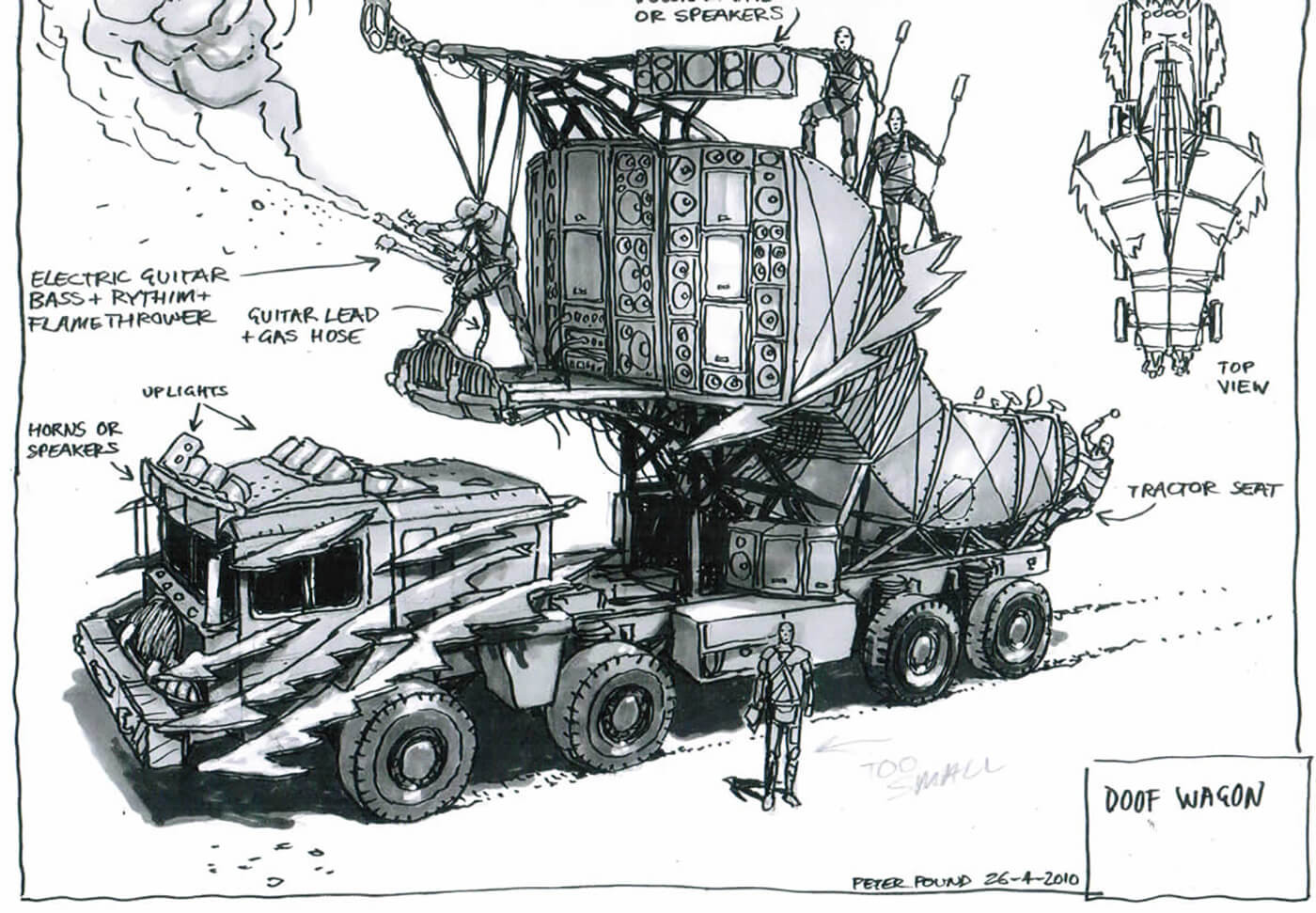 Peter Pound’s concept art, 2010
Peter Pound’s concept art, 2010
Peter Pound’s 2010 concept art, revealing the early vision for the Doof Wagon, hinting at the guitar’s prominent role in the sonic chaos.
He continues, recalling Gibson’s instructions: “[Colin] was like, ‘There are three stipulations: it has to have two necks, it has to look like the sickest weapon, and it has to throw flames 45 feet’. I was like, ‘That’s it? Done.’” Ulman, despite never having built a guitar before, embraced the challenge with characteristic enthusiasm. The functional requirements of the guitar remained vague initially. It was unclear whether it needed to be playable, or simply visually striking. Ultimately, Ulman was granted creative freedom to sculpt his vision, with the practicalities of functionality to be addressed later. He had two months to bring this sonic weapon to life.
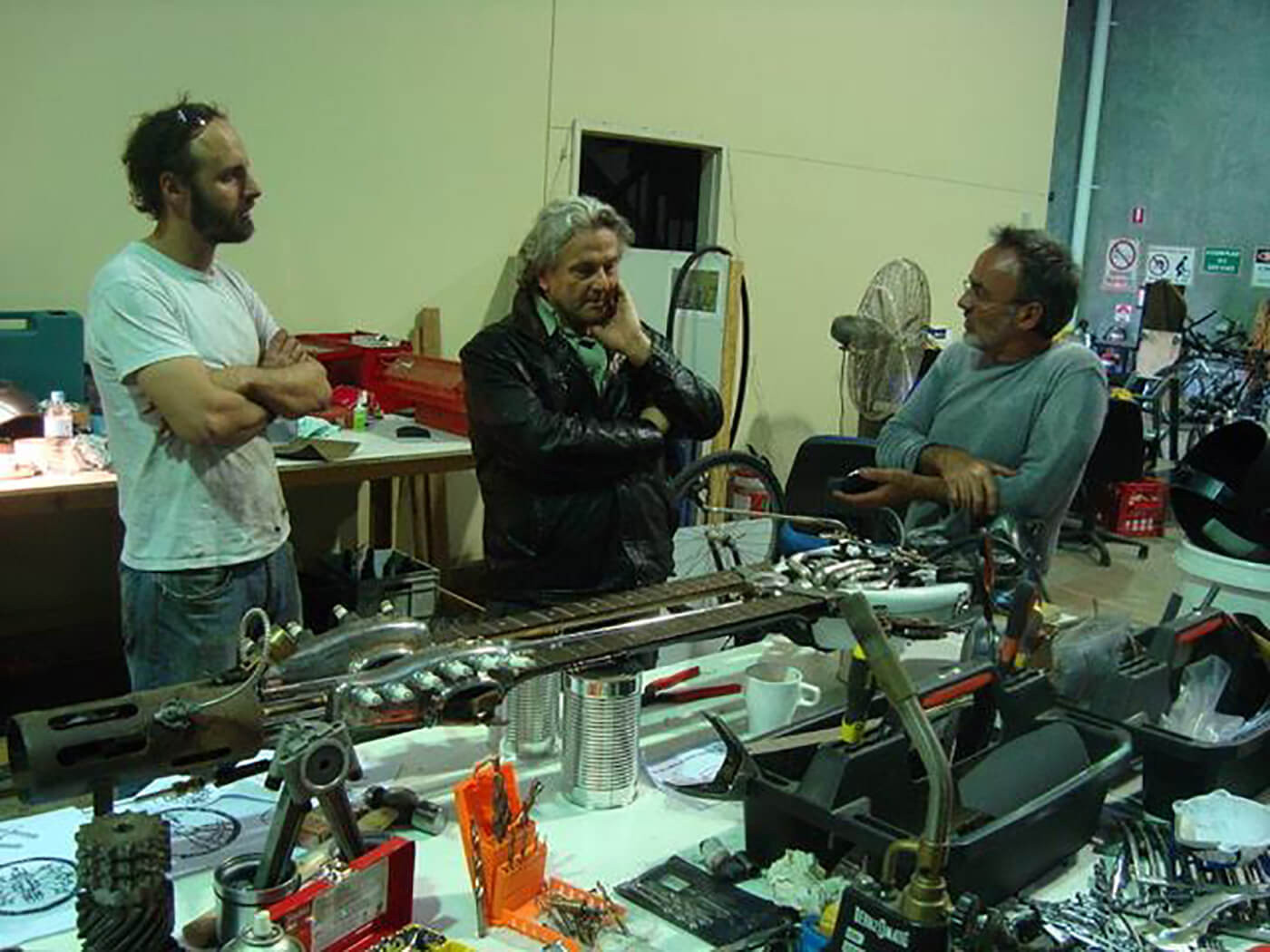 Ulman with Miller and production designer Colin Gibson
Ulman with Miller and production designer Colin Gibson
Michael Ulman pictured with George Miller and production designer Colin Gibson, highlighting the collaborative process in bringing the Fury Road universe to life.
“No-one knew what the guitar was going to be like,” Ulman explains. “They told me what they wanted, they gave me a frickin’ wad of cash, and they put me with this guy who took me to the junkyard. The junkyards in Australia are insane. Acres and acres and acres and acres. The production company would be like, ‘Okay, we’ll take that acre of junk’, box it all up and take it to the facility so the guys could go through it. They didn’t care what the fuck was in it. I just went hog wild digging through parts. Bells and whistles and bumperettes and spark plugs. All this amazing stuff. I got it back there, laid it out on the table, and I started building.” Ulman dove headfirst into this treasure trove of discarded materials, his imagination ignited by the sheer volume of potential components.
Sifting through mountains of refuse, alongside finds from antique and bric-a-brac shops, Ulman meticulously gathered the components for his post-apocalyptic instrument. Forget exotic tonewoods and fine nitrocellulose finishes; this guitar was to be forged from the grit and grime of the wasteland.
For the guitar’s body, Ulman ingeniously repurposed a bedpan (take note, Leo Fender enthusiasts!). He bisected it horizontally, filling its cavity with tuba valves to create a unique, resonant core. The body was further embellished with car horns, voltage dials, and a fragmented Zildjian cymbal. True to his “speed shit” aesthetic, he even incorporated a motorcycle kickstand as a whammy bar. To unify these disparate elements, Ulman constructed a lattice-style metal skeleton, providing a framework to which the various parts could be attached.
 Ulman’s V1 guitar – notice that the strings aren’t yet connected
Ulman’s V1 guitar – notice that the strings aren’t yet connected
Ulman’s initial V1 guitar sculpture, showcasing the raw, artistic vision before the integration of functional guitar components.
To ensure playability, the instrument required standard guitar and bass necks. Ulman sourced two single necks, one guitar and one bass, capping their headstocks with Chevy bumperettes adorned with spark plugs. He envisioned connecting the spark plugs to the tuning mechanisms, allowing them to function as tuning pegs, but time constraints prevented this intricate detail. Ulman’s two months were up. He completed his Frankensteinian creation and prepared to return to Boston, leaving his sculpted masterpiece in the hands of the Fury Road team to be brought to life.
From Sculpture to Six Strings: Fine-Tuning the Fury
Matt Boug, an Australian industrial designer and propmaker, joined Fury Road as a junior member in 2010, marking his first foray into full-length live-action feature films. Initially assigned to the “speed shit” department, Boug’s early task was to “dress” motorbikes in the signature Mad Max style. After embellishing the motorcycles, he transitioned into a troubleshooting role for production designer Colin Gibson, focusing on the challenge of transforming Ulman’s impressive sculpture into a functional musical instrument.
At this stage, the Fury Road guitar remained a visually striking sculpture, lacking functional guitar parts, pickups, or even strings. Boug’s mission was to refine Ulman’s artwork, securely fix the components, refine the aesthetics, and, crucially, integrate electronics to make it playable. In Ulman’s words, “Matt had the painstaking task of taking apart all my cool shit and trying to shove some other shit in there to make it work.”
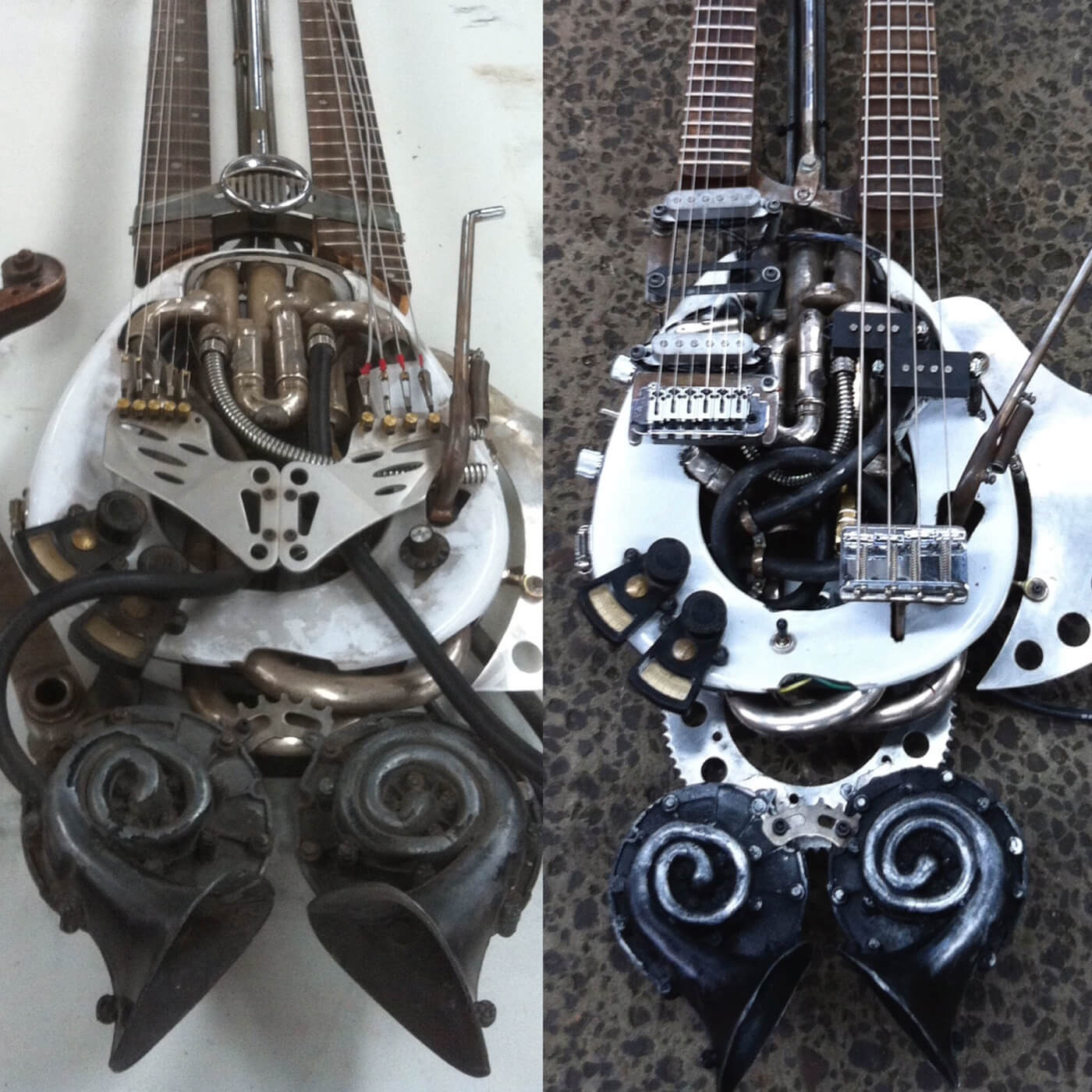 Side-by-side of Ulman’s V1 sculpture and the finished guitar
Side-by-side of Ulman’s V1 sculpture and the finished guitar
A side-by-side comparison highlighting the transformation from Ulman’s artistic sculpture to Boug’s functional, stage-ready Fury Road guitar.
Boug, while familiar with guitars from his upbringing, had never constructed one before. Seeking inspiration, he turned to the legendary Brian May, the Queen guitarist renowned for building his iconic “Red Special” guitar from household materials. “I remembered that in my childhood I’d read an article about the Red Special,” Boug recounts. “He made that out of old stuff from his house – there was a piece of wood from his mantelpiece, and some of the springs are old motorbike parts.” Boug located the article, hoping May’s DIY approach might provide guidance. However, it had the opposite effect. “It completely daunted me,” he admits. “I was like, ‘Wow, this is an epic undertaking.’”
Instead of replicating May’s intricate luthiery, Boug drew on his experience working on Fury Road‘s vehicles, deciding to approach the guitar construction with a similar mindset. Meanwhile, production designer Gibson had acquired a budget, unbranded double-neck guitar, which landed on Boug’s workbench with a straightforward directive: combine this double-neck with Ulman’s sculpture and “make it work.”
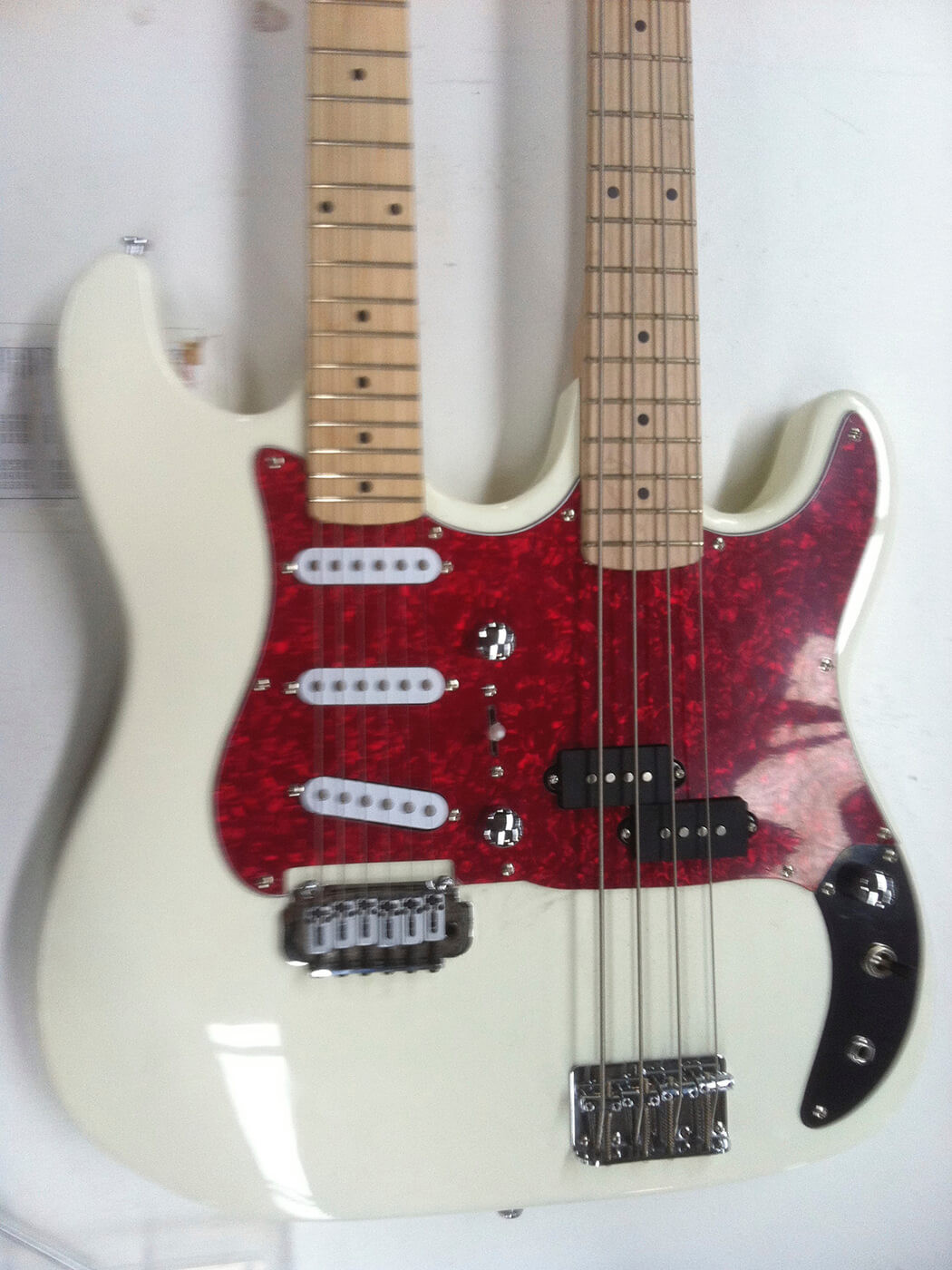 This Fender-style double-neck guitar/bass was cannibalised for parts
This Fender-style double-neck guitar/bass was cannibalised for parts
The Fender-style double-neck guitar, sacrificed for its functional parts, highlighting the pragmatic approach to creating the Fury Road guitar.
Ulman’s original guitar and bass necks, sawn off at the 20th and 22nd frets respectively, were replaced with the full-length necks from the Fender-style double-neck. Securing these new necks was the next challenge. “Michael had put all the pieces together but it needed something to hold it all together, kind of like a chassis,” Boug explains. “So the first thing I did was conceive a chassis to fit into Michael’s structure so that I could hold the neck and the bridge in tension properly. I built a chassis and then bolted all the panels on it.” This internal chassis became the structural backbone of the Fury Road guitar.
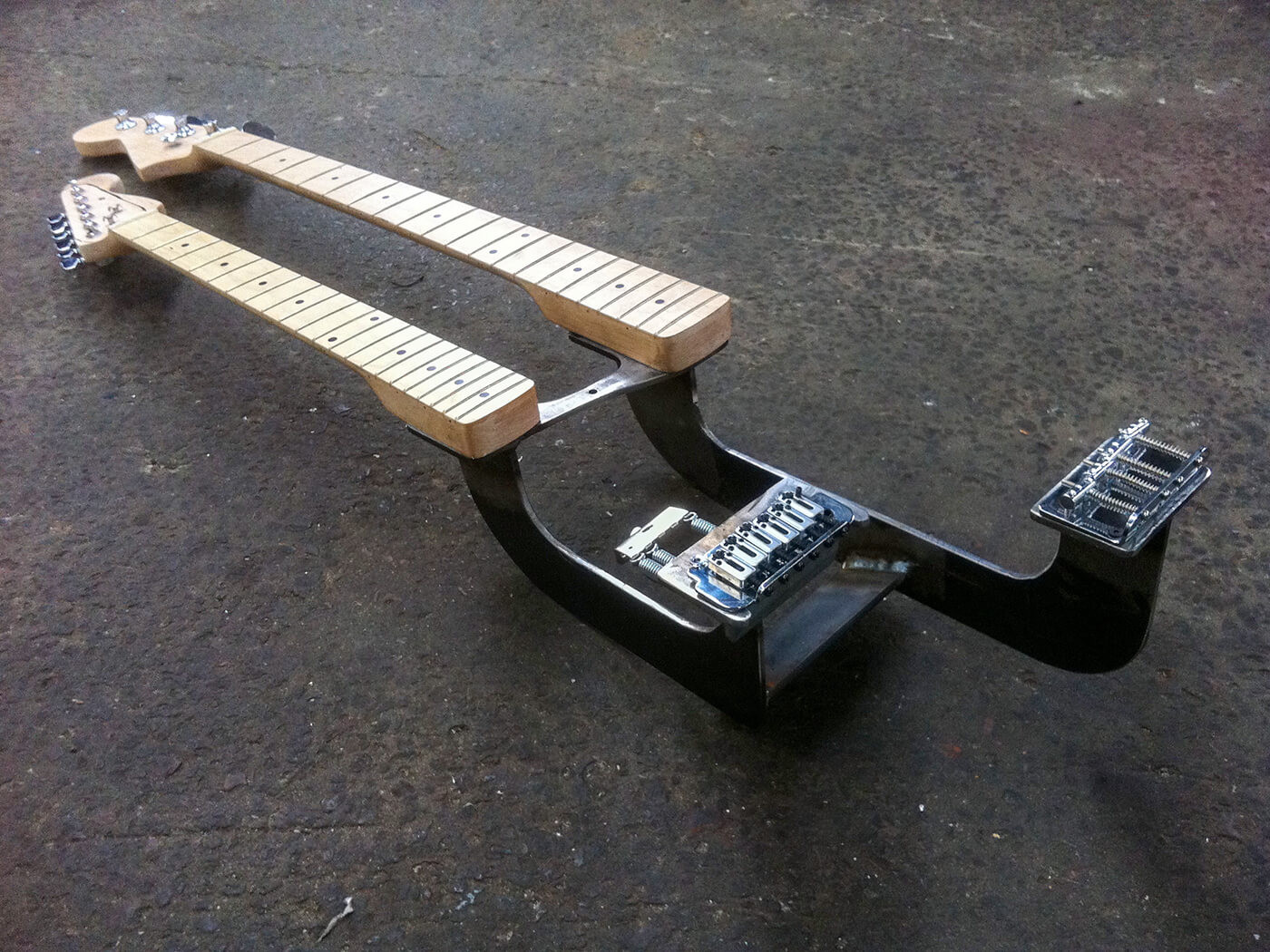 Boug’s DIY chassis would hold the necks and bridges in tension
Boug’s DIY chassis would hold the necks and bridges in tension
Boug’s custom-built chassis, the hidden framework that provided structural integrity and playability to the Fury Road guitar.
Faced with the inexpensive pickups from what he believed was an Asian-made Fender copy, Boug expressed concerns about their quality. He advocated for higher-grade electronics to ensure reliability in the harsh Namibian desert environment. “I wanted to make it all really good-quality so that it wasn’t a problem when we got to Africa,” Boug says. “But [Colin] insisted that I just use this stuff. And I suppose you can’t be picky when you’re in the wasteland; I just had to make do with what I was given.”
Fitting the electronics within the already densely packed guitar body proved to be a significant challenge. Boug had to repeatedly disassemble and reassemble the guitar to integrate the electronics, eventually encasing them within Ulman’s sculptural exterior and his new chassis. The finished instrument featured three Strat-style single-coil guitar pickups, two Precision-style bass pickups, a volume control, a tone control, a guitar pickup selector switch, and a switch to toggle between guitar and bass modes, or to activate both simultaneously. The flamethrower fuel line, capped with a protective sheath fashioned from halved truck exhaust pipes, ran between the necks and was controlled by the repurposed motorcycle kickstand whammy bar.
 Boug testing the guitar
Boug testing the guitar
Matt Boug meticulously testing the Fury Road guitar, ensuring its functionality before its on-screen debut in the harsh desert environment.
“It was epic,” Boug reflects. “There were more than 400 pieces, with all the little connecting screws and the plumbing for the flamethrower. It was complex to disassemble. It was never designed to be pulled apart and put together. I struggled to get all the electronics in.” The Fury Road guitar became a microcosm of the film itself: a complex, loud, and visually arresting creation built from countless individual parts.
To further align Ulman’s sculpture with the film’s gritty aesthetic, Boug added subtle details. He affixed a Datsun 1600 name badge to the repurposed Zildjian cymbal, adding a “car element” to reinforce the Mad Max world’s automotive obsession. To give the guitar a suitably post-apocalyptic appearance, Boug even used a blowtorch to char the inexpensive necks and fretboards – a deliberate “roasted maple” effect achieved through decidedly unconventional torrefaction methods.
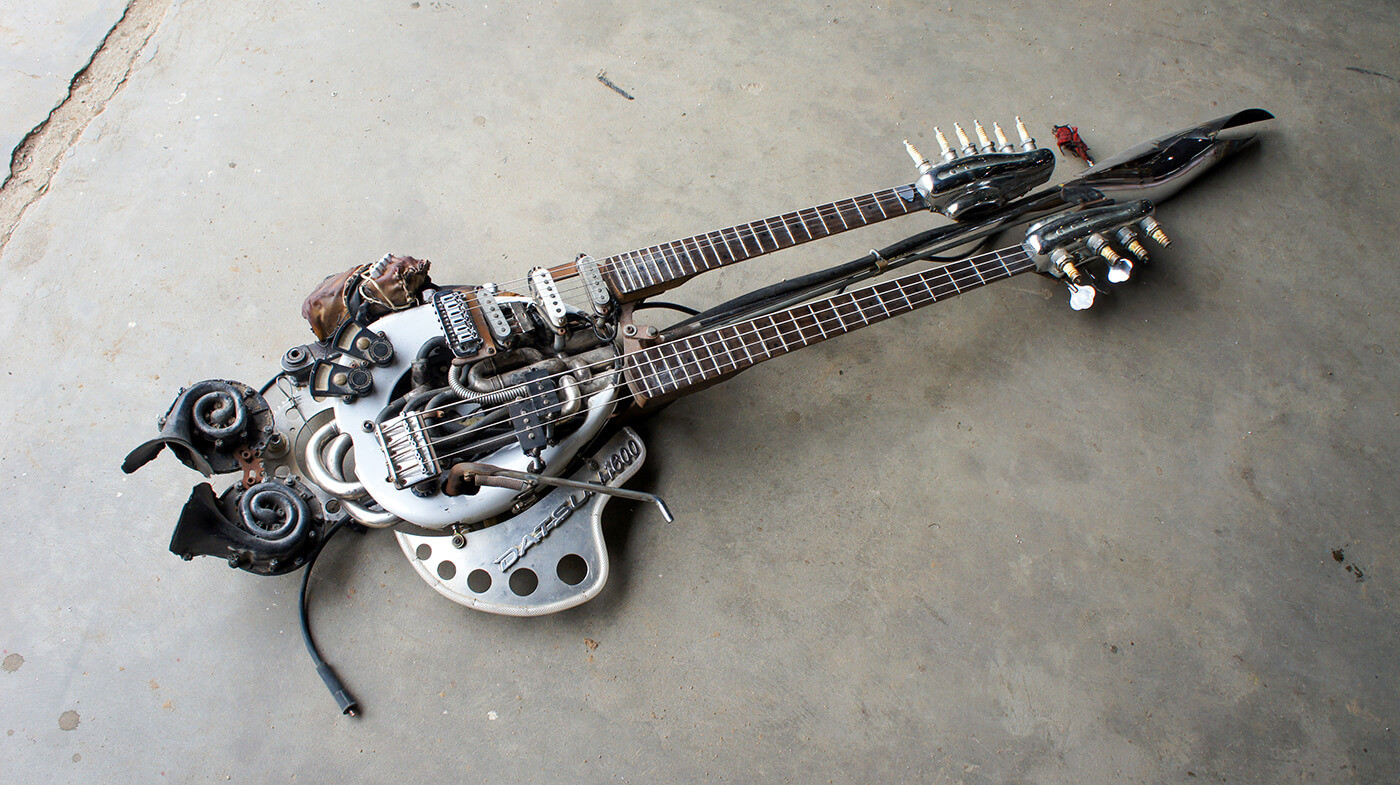 The finished Fury Road guitar
The finished Fury Road guitar
The completed Fury Road guitar, a testament to creative repurposing and collaborative craftsmanship, ready to unleash sonic and visual mayhem.
With the guitar completed and pre-production in Sydney finalized, Ulman and Boug’s creation was shipped to Namibia in early 2011. The next step was finding the musician who would wield this incredible instrument.
The Doof Warrior Ascends: iOTA and the Call of the Guitar
Black leather gimp mask, blackened teeth, a Cherry Red Gibson SG – iOTA arrived at his 2012 screen test fully embracing the Mad Max aesthetic. “I just wore what I would’ve worn if I was in Mad Max 2,” he explains, “some feathers, black eyes and brown teeth, leather and stuff.” iOTA, with his background in stage productions like Hedwig and the Angry Inch and The Rocky Horror Show, and a lifelong Mad Max fan since childhood, was no stranger to outlandish costumes and performance.
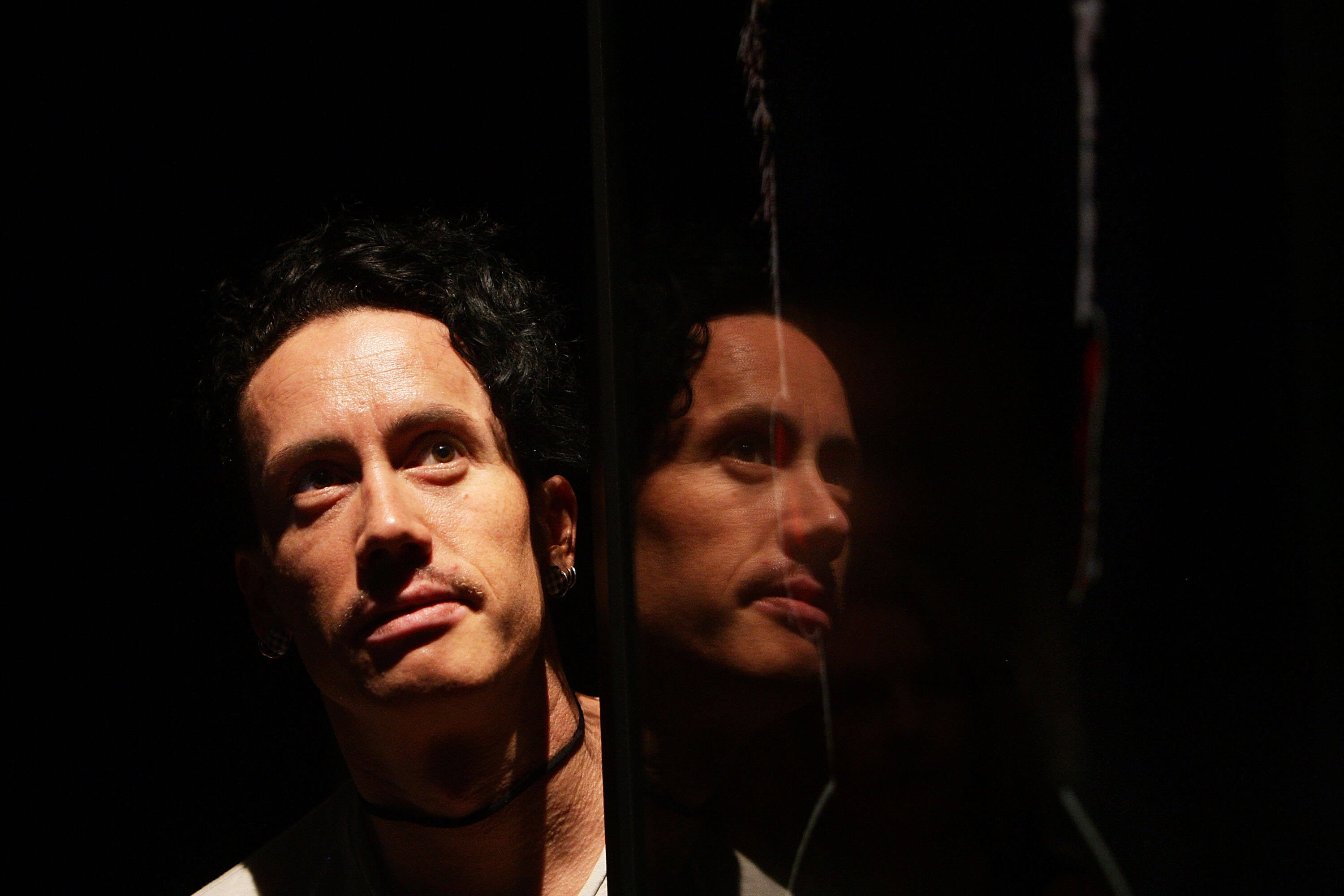 iOTA at the Sydney Theatre Company, 2012
iOTA at the Sydney Theatre Company, 2012
iOTA in 2012, showcasing his theatrical flair and stage presence, qualities that made him the perfect fit for the Doof Warrior.
The Australian-Māori actor and musician, already with four studio albums and numerous stage roles to his name, auditioned for the Doof Warrior role in 2012, SG in hand. He secured the part with an audition that prioritized raw energy over technical guitar virtuosity. “To be honest, I could’ve gone in there and just noodled and that would’ve been enough,” he admits. “I didn’t really do much. I just made a lot of noise. It was more the physicality. George really liked that I leaned forward and put one of my legs out the back. I remember him saying to me, ‘As soon as you did that, I knew you were the right one for the job’.” While other actors showcased technical guitar skills, Miller was searching for a performer who embodied the primal energy of the Doof Warrior.
“It was weird. I had no idea what this character was going to be like or how a guitarist was going to fit into the Mad Max world,” iOTA recalls. “But I figured it would just be rough, y’know? It would be something that was guttural, screeching, rather than…” he demonstrates intricate fretwork. His aggressive physicality, rather than guitar proficiency, landed him the role.
Days later, iOTA visited Kennedy Miller Mitchell headquarters in Sydney, where he received a deeper understanding of his character. “I walked into the office,” he says. “There was a great big table with George Miller sitting at the end of it. The room was surrounded by storyboards, and there were model trucks and little figurines all around. There was a truck that was the Doof Wagon. I saw this truck thing with speakers everywhere and a little guy dangling on a rubber band on the front. I was like, ‘Wow, that’s cool,’ and he was like, ‘Yeah, that’s gonna be you’.” The realization dawned on iOTA: he wasn’t just playing a character; he was becoming a living, breathing part of the Mad Max machine.
Heavy Metal Mayhem: Wielding the Weaponized Guitar
When Michael Ulman initially conceived the Fury Road guitar, ergonomic considerations were secondary to visual impact. “In my head, it doesn’t have to work,” he reiterates. “I wanted to make it so [whoever would have to play the guitar] could hold it comfortably. But in my head, ‘comfortably’ just meant that his hand placement and the strap were right. I didn’t think about weight.”
Fortunately, Miller and his team did. The guitar, weighing a hefty 58 kilograms (approximately 128 pounds), presented a significant challenge for iOTA to wield while performing on a moving vehicle. The production team devised a solution inspired by the very figurines iOTA had seen in Miller’s office.
In a decidedly low-tech yet effective approach, they mounted the Fury Road guitar on bungee cords to alleviate its immense weight from iOTA’s shoulders. However, with iOTA also suspended by bungee cords on the Doof Wagon, a massive German 8×8 military truck, simply holding and “playing” the instrument became a physical battle.
Months after his initial meeting, iOTA found himself in the Namibian desert, confronted with the full-scale reality of the Fury Road guitar. “The whole thing was just such a trip. I couldn’t believe what was happening. When I got to Namibia, it was hanging on some sort of rack. It was plugged in and I just got onto it as quickly as I could. I climbed up the ladder and they strapped me in and it felt like you were on the second storey of a building looking down. It was very cumbersome and not at all pleasant to play. But it made total sense. You really had to fight with it.” The sheer unwieldiness of the guitar became integral to the Doof Warrior’s performance, adding to the character’s chaotic and imposing presence.
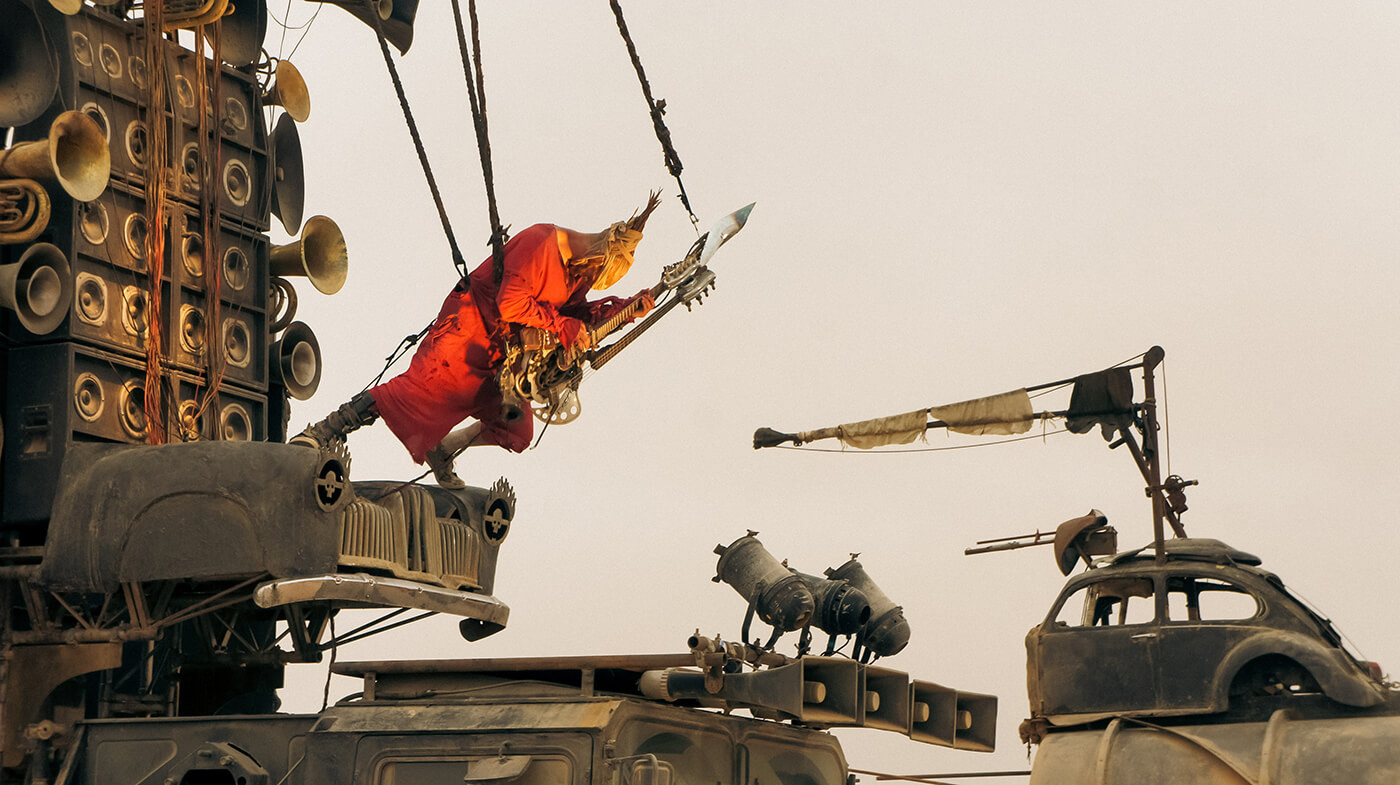 iOTA on set, strapped to the Doof Wagon, possibly napping
iOTA on set, strapped to the Doof Wagon, possibly napping
iOTA on the set of Fury Road, suspended on the Doof Wagon, embodying the physical demands of performing as the Doof Warrior.
As iOTA experimented with the flame-spewing double-neck, he quickly recognized its sonic limitations. “I loved the sounds that came out of it,” he says. “But it was all a little too clean. That’s why I suggested we get a distortion pedal on it and just treat it like a gong, just more of an angry atmosphere – make it scream and screech rather than try to play a riff or something.” The focus shifted from nuanced guitar playing to creating a raw, visceral soundscape.
iOTA acquired a DigiTech Hardwire SC-2 Valve Distortion pedal, the “most distorted pedal” he could find in Swakopmund, Namibia. This pedal, housed in a custom leather pouch attached to the guitar, became crucial in shaping the Doof Warrior’s sonic identity. “It looked really cool,” iOTA notes. “It just looked like it’d been there forever.”
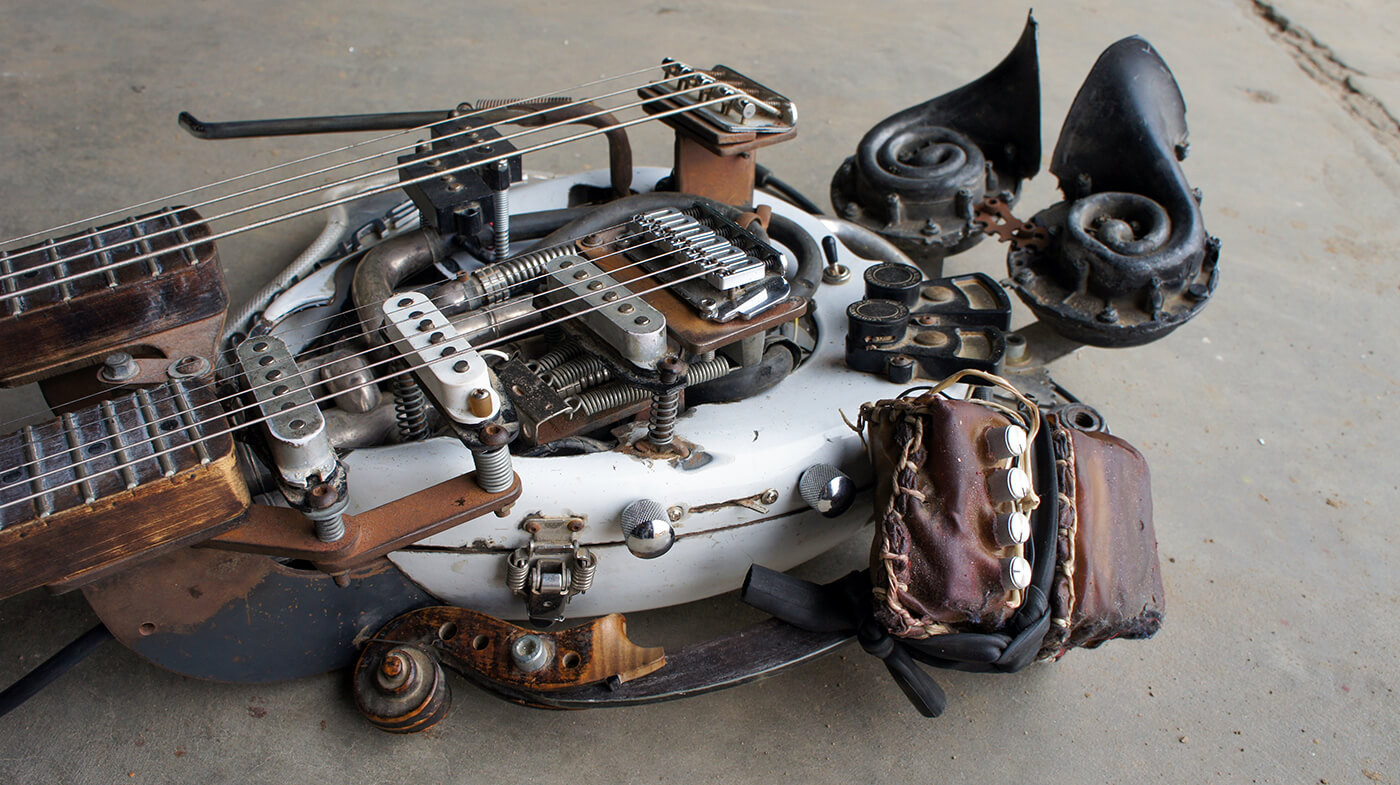 Close-up of the guitar’s construction, including pickups and distortion pedal
Close-up of the guitar’s construction, including pickups and distortion pedal
A detailed view of the Fury Road guitar’s construction, revealing the pickups, hardware, and the strategically placed distortion pedal for maximum sonic aggression.
With iOTA secured and the sound amplified, he was given free rein to improvise, including unleashing the flamethrower. “‘Yeah, just do it every now and then. Whatever. Just have a go,’” he recalls being told. “There was a couple of different runs that we did where, you know, ‘Can you just do heaps of the flame this time?’ Lots of different ideas.” However, the guitar’s flamethrower proved less visually dramatic on film than anticipated, leading to the incorporation of CGI flames in the final cut.
“Basically that was my brief the whole time: just get up there and do what you want to do. Just rock. Be crazy,” iOTA summarizes. “It was very physical. You’ve got protection on your knees, pads anywhere you feel that you might get injured. They were very careful. That’s all it was: ‘How are you feeling? Are you ready to have a run?’ It’s a crazy feeling to be hanging there, fighting against [the guitar] as the truck’s turning. It was wild. It was fuckin’ wild. I was just screamin’ my head off. It was like a roller coaster.” The experience was physically demanding and inherently risky.
When scenes became too dangerous for iOTA, stunt performers took over. A “stunt guitar,” built by Burt Burless, was also created for these sequences. “Whenever there’s a fight or a stunt in movies like Fury Road, there’ll be some kind of soft version of the weapon,” explains Matt Boug. “It was basically a process of taking the guitar that we’d built and then moulding and casting that into a version that looked exactly the same but was made out of softer materials, like foam rubber and soft plastics.”
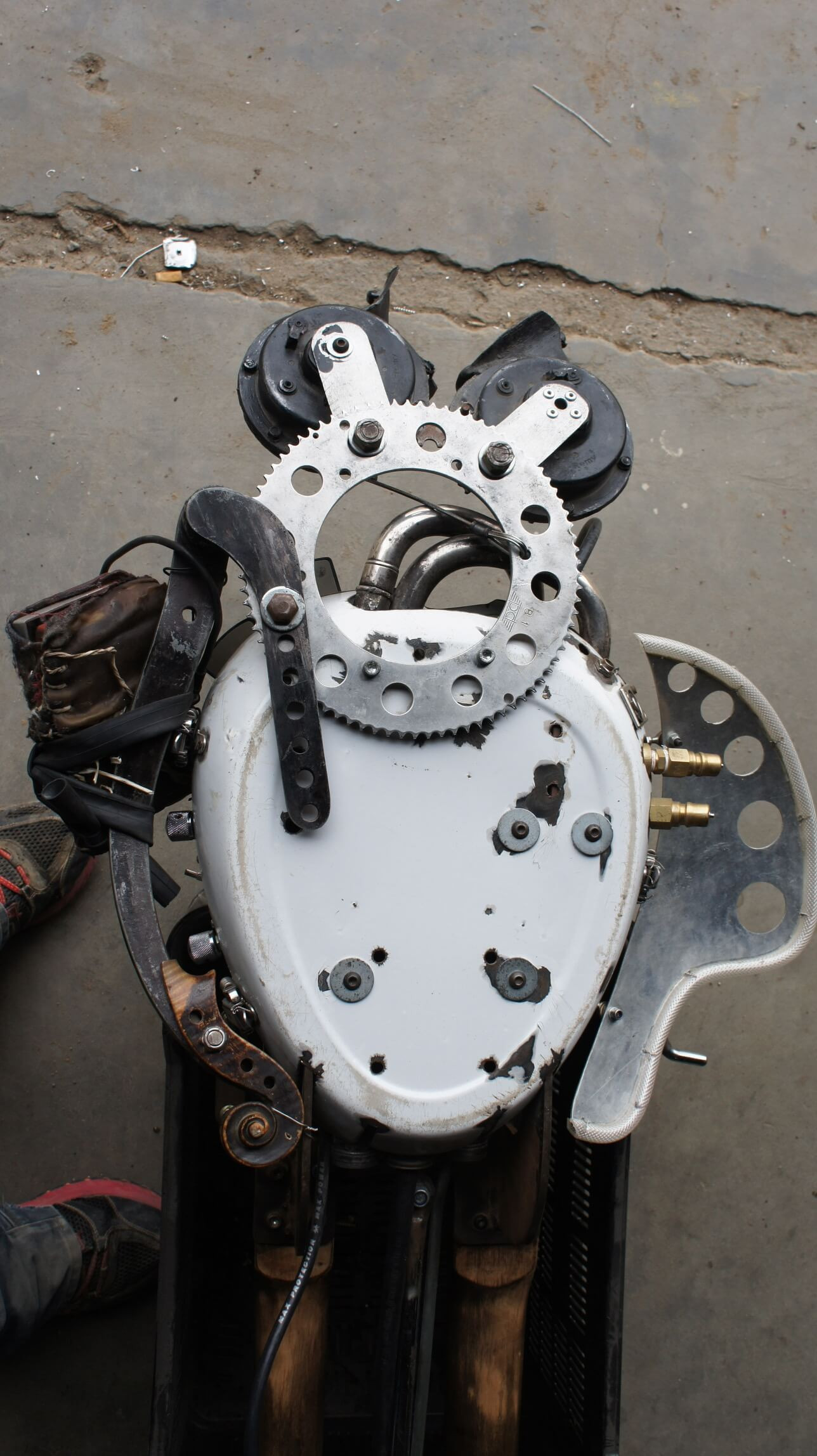 Rear of the guitar
Rear of the guitar
The rear view of the finished Fury Road guitar, showcasing the intricate details and the robust construction required for its demanding on-screen role.
Despite the stunt double and the stunt guitar, the original Fury Road guitar endured its share of desert hardships. “The guitar was probably there for eight or nine months,” Boug recounts. “I tried to shrinkwrap as much of the electronics as I could to protect it from the elements. But a lot of it was exposed. It got dropped a couple of times, which broke the electronics. I had to pull it all apart, figure out what had broken and then put it back together again.”
The Doof Wagon’s sound system, including a small amp positioned beneath iOTA, also suffered the desert’s wrath. “It was cranked,” iOTA says. “By the end of [the shoot], it probably wasn’t even making any sound because it was fucked. But you could barely hear it. There was trucks and wind and explosions and people yelling. It was complete mayhem.” The chaotic on-set environment rendered iOTA’s live guitar performance largely unusable in the final film.
Instead, George Miller enlisted Dutch composer Tom Holkenborg, known as Junkie XL, to create the film’s score. Holkenborg drew inspiration from stoner rock and bands like Kyuss, using a Cherry Red ’74 Gibson SG and a Silverburst 2012 Les Paul Studio, tuned down to CGCGBE, and amplified by Fulltone pedals and an Orange Thunderverb 200 Head to achieve the Doof Wagon’s earth-shattering rumble.
The Guitar’s Legacy: From Fury Road to Fan Replicas
Many of the elaborate vehicles crafted for Fury Road were not salvaged after filming. “There was some stuff that got destroyed,” Boug confirms, “some of the cars and bikes, stuff that George knew he was never going to use again, that all got crushed over in Africa. They picked select things to take back to Australia, some for the reshoots that took place there, others that George was fond of.”
Fortunately, the Fury Road guitar was among the saved artifacts. It currently resides in storage at Kennedy Miller Mitchell, a testament to its iconic status. However, it’s not the only Fury Road guitar in existence. Inspired by fan demand, its creator, Michael Ulman, has built replicas.
“When I try to sell my art, I’m like, ‘Oh, buy a motorcycle, buy a hot rod, buy this, buy this’,” Ulman says. “When I finally work up the courage to say, ‘Hey, I made the guitar for Mad Max: Fury Road’, their minds… everything just drops. Two people were like, ‘I–want–one!’, so I made them their own, two different versions. I would never have thought that anybody would’ve wanted that. But there’s a huge fanbase for this guitar. People are making crazy stuff of the guitar and they don’t even really know who built it.”
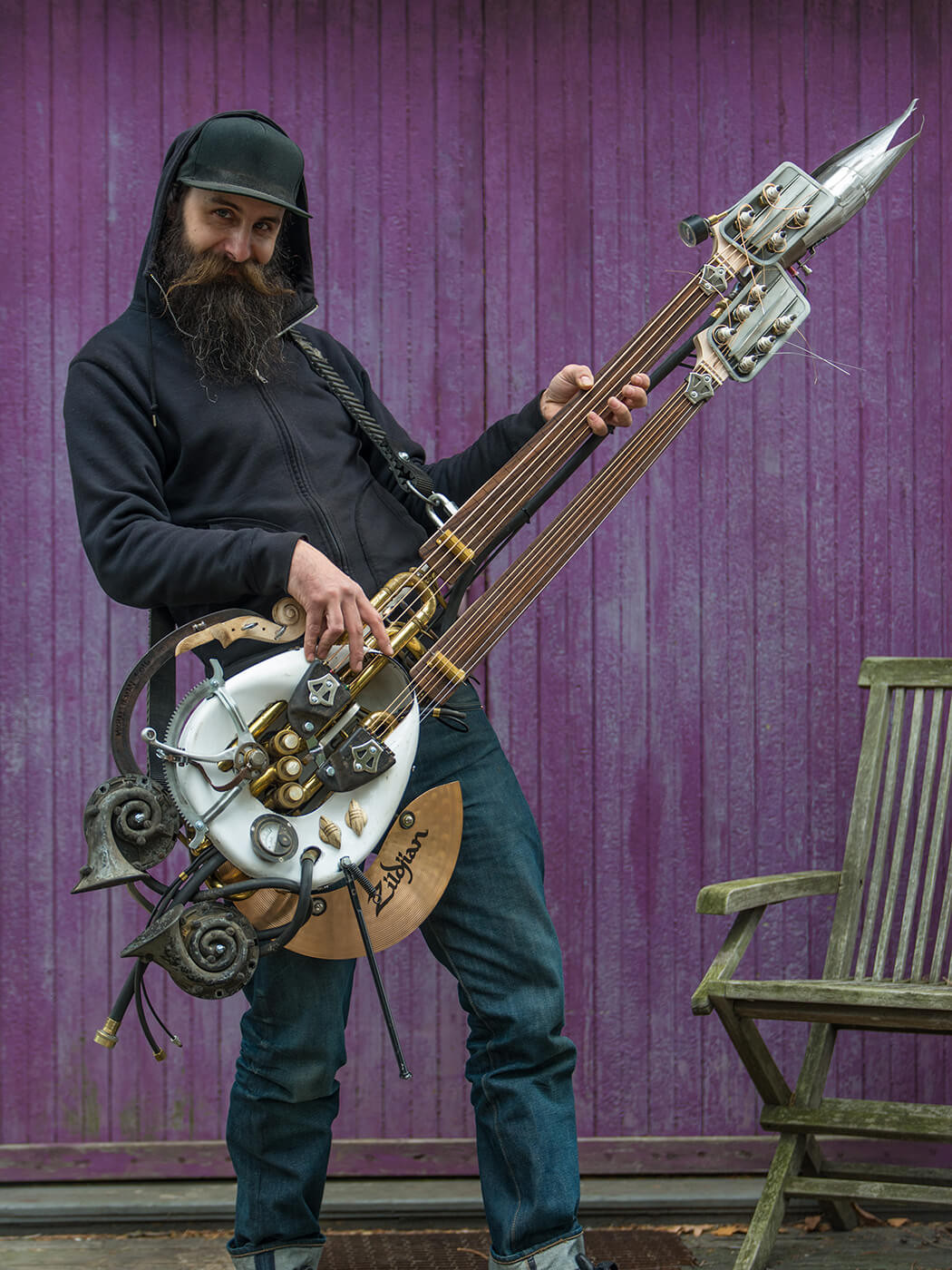 Ulman with one of his privately commissioned replica Fury Road guitars
Ulman with one of his privately commissioned replica Fury Road guitars
Michael Ulman with a privately commissioned replica Fury Road guitar, demonstrating the enduring appeal and iconic status of his creation.
Ulman is right about the fanbase. Since Fury Road‘s release, the Doof Warrior and his guitar have become pop culture phenomena, parodied by Conan O’Brien, Seth Meyers, and Funny or Die. Fan-made recreations abound online, from a modified Epiphone Les Paul to a flamethrowing ukulele. The Fury Road guitar and iOTA’s Doof Warrior have even been immortalized as a Funko Pop figurine, solidifying their place in cinematic history.
“It just holds its own weight in that movie,” Ulman concludes. “It’s such a character. When I say to people, ‘Do you remember the guitar?’ they’re like, ‘That guy was my fucking favourite!’” The Fury Road guitar transcends its status as a movie prop; it’s a symbol of the film’s狂野 creativity, a testament to collaborative artistry, and a true rock and roll icon forged in the fires of cinematic madness.
